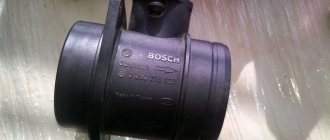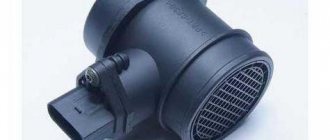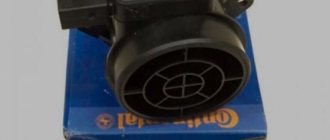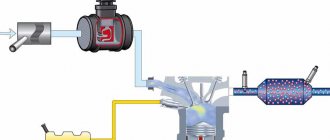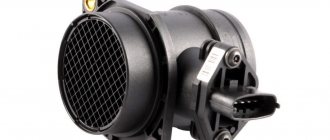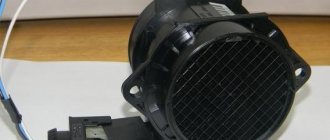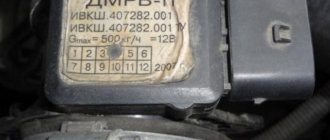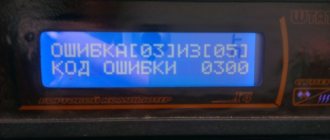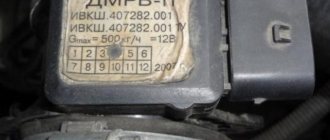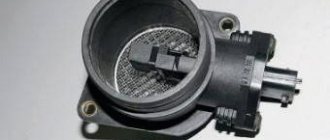Every car enthusiast who understands the design of cars knows what an air flow sensor is and what functions it performs. However, not every motorist has an idea of how to clean the mass air flow sensor with your own hands and what is needed for this. In this article we will talk in detail about the cleaning process and the choice of substance for this purpose.
How to check for a faulty air flow sensor?
The parameters transmitted by the mass air flow sensor play a large role in the balanced formation of the combustible mixture. Accordingly, breakdowns associated with the operation of the air sensor can lead to disruption of the functionality of the system as a whole. In some cases, incorrect operation of the sensor may make it impossible to start the engine.
Let's look at the signs by which you can determine if the mass air flow sensor has failed:
- the Check Engine light comes on on the dashboard;
- increased fuel consumption;
- decrease in the level of power and traction of the car;
- decrease in dynamics with increasing car speed;
- Difficulty starting the engine or the impossibility of starting it at all;
- in idling mode, the unit speed will float.
Design and designation of mass air flow sensor elements
Of course, such malfunctions indicate not only a malfunction of the mass air flow sensor, but also other failures. Therefore, a car enthusiast should know how to correctly determine the incorrect operation of the regulator. To carry out diagnostics, there are several options, the simplest of which is to turn off the power from the mass air flow sensor while the engine is running.
After the power is turned off, the machine control unit begins to operate in emergency mode; in this case, the dosage of gasoline, diesel or gas is carried out according to the readings received from the throttle. Note that in this case the idle speed may begin to increase to 1500, but in some injection engines the speed does not increase. When the mass air flow sensor is disabled, you need to drive the car. If engine performance has improved, the mass air flow sensor will need to be replaced or cleaned.
Step-by-step process
Purchase the required liquid, take a disposable syringe and a flat-head screwdriver. Even if you are a pro and know every crack of your car, still read the instructions again on how to clean the mass air flow sensor on a VAZ 2114. If you opened the hood of your fourteenth for the first time and you feel itchy, pray that everything goes smoothly, while reading the instructions at the same time.
- We opened the hood, found the sensor, removed it (loosen the fastening of the air filter hose with the sensor, unscrew the two nuts with a ten-point socket wrench and voila, done);
- There is a part on the sensor that is screwed to its body with two bolts; it must be unscrewed;
- Inside, we spray the necessary liquid from a syringe onto the sensitive element (you can also rinse the contact system of the block);
- Let it dry.
All that remains is to put everything back in place and start the engine.
Flushing may not help the first time, so don’t get upset and repeat the process. If it still doesn’t help, you’ll have to buy a new air meter.
The mass air flow sensor is a device without which normal engine operation is impossible. Performance on the functionality of the power unit. How to determine if the flow meter is faulty and how to clean the mass air flow sensor - you can find the answers to these questions below.
[Hide]
Which cleaner should you choose?
If you decide to clean the mass air flow sensor yourself, you need to choose the right product:
- Liqui Moly. To clean the regulator, you can use Liqui Moly liquid. Liqui Moly is known for all its automotive products. Products from the manufacturer Liqui Moly are characterized by high quality, as well as a considerable price. The liquid mass air flow sensor cleaner Liqui Moly is an effective product in practice. As practice and reviews from car enthusiasts show, Liqui Moly allows you to effectively get rid of contaminants and if the air sensor is in working condition, after cleaning it can work for a long time. This product is suitable for both petrol and diesel units. The cost of Liqui Moly today is about 12 USD. e.
- Alcohol. You can clean the air sensor the old fashioned way - using alcohol. Alcohol allows you to effectively break down dirt and blockages. The use of alcohol was relevant twenty years ago; today this method is rarely used. To deceive the car owner and bill him for flushing the regulator with a cleaning agent. This practice occurs frequently at our service stations.
- Liquid for cleaning carburetors. One cheap option to clean the device is to use carburetor cleaner. The cost of one cylinder is about 1.2 dollars. If you believe the reviews of car enthusiasts, this analogue is no less effective than Liqui Moly, while its cost is ten times lower.
- "Liquid Key" Also a domestic product, sold in the form of a spray. The product is intended to rid various vehicle components and assemblies of frozen contaminants.
- WD-40. Many motorists have such a tool. In practice, WD-40 has long shown its effectiveness, so many car enthusiasts use it for these purposes. It can also be used to clean the air sensor (video author - Pavel Ksenon).
Checking and repairing at home
There are eight ways to independently check amplitude and frequency mass flow sensors.
Method No. 1 - disabling the air flow meter
The method consists of disconnecting the sensor from the fuel system of the car and checking the functionality of the system without it. To do this, you need to disconnect the device from the connector and start the engine. Without a mass air flow sensor, the controller receives a signal to switch to emergency operation mode. It prepares the air-fuel mixture only based on the throttle position. If the car moves faster and does not stall, it means that the device is faulty and requires repair or replacement.
Method No. 2 - flashing the electronic control unit
If the standard firmware has been changed, then it is unknown what reaction of the controller is programmed in it in case of an emergency. In this case, you should try to insert a 1mm thick plate under the throttle stop. The turnover should increase. Now you need to pull out the chip from the air flow meter. If the power unit continues to work, then the cause of the malfunction is the firmware.
Method No. 3 - installing a working sensor
Install a known good part and start the engine. If after replacement it begins to work better, the motor does not stall, then replacement or repair of the device is required.
Method No. 4 - visual inspection
To do this, use a Phillips screwdriver to unscrew the clamp holding the air collector corrugation. Then you need to disconnect the corrugation and inspect the internal surfaces of the air collector corrugation and the sensor.
Inspection of duct corrugation
There should be no traces of oil or condensation on them, the surfaces should be dry and clean. If you do not take care of the air filter and change it rarely, then dirt can get on the sensitive element of the sensor and cause it to break. This is the most common malfunction. Traces of oil may appear in the flow meter if the oil level in the crankcase is high, or if the oil sump of the crankcase ventilation system is clogged. If necessary, you need to clean the surfaces using special cleaning products.
Method No. 5 - checking the mass air flow sensor with a multimeter
To do this, you need to turn on the tester in a mode in which constant voltage is checked. The limit value for measurements should be set to 2V.
DMRV operation diagram
Sensor pinout:
- The yellow wire is located closer to the windshield. It serves as an input for a signal from the flow meter.
- The white-gray wire is the sensor voltage output.
- The black and pink wire leads to the main relay.
- The green wire is used to ground the sensors, that is, it goes to ground.
The wires may have different colors, but their location is unchanged. To check, you need to turn on the ignition, but do not start the car. The red probe from the multimeter must be connected to the yellow wire, and the black one must be connected to ground, that is, to the green wire. We measure the voltage between these two outputs. Multimeter probes make it possible to connect without disturbing the insulation of the wires.
On the new device, the output voltage ranges from 0.996 to 1.01 V.
During operation, this voltage gradually increases and by its value one can judge the wear of the flow meter:
- if the sensor is in good condition, the voltage is from 1.01 to 1.02 V;
- in satisfactory condition - from 1.02 to 1.03 V;
- the sensor resource ends if the voltage is in the range from 1.03 to 1.04 V;
- a value in the range from 1.04 to 1.05 indicates a near-death state; if there are no contraindications, then you can continue to use the sensor;
- if the voltage exceeds 1.05 V, the mass air flow sensor requires replacement.
Indications of the ADC of the flow meter
Diagnostics of the mass air flow sensor "Tseshkoy" is not complicated and can be done with your own hands.
If there is dirt on the removed sensor, you can clean it yourself. You can use WD-40 to wash it. To clean the mass air flow sensor, you must first remove the pipe from it, and then dismantle the device itself. Inside the device there is a mesh and several wires - sensors.
They need to be sprayed with cleaning agent and washed. Then let the liquid dry. If dirt remains, the procedure should be repeated. You need to clean the pipe with the same product. It must be free of dirt and oil stains. After replacing the air filter, all parts must be returned to their place. After the cleaning procedure, the functionality of the device can be restored to 80%, the error about the reduced sensor signal level disappears (the author of the video is “24 hours”).
Flushing the sensor will help avoid costly repairs.
Method number 6 - checking with a scanner
Test method:
- Install a diagnostic program on your phone (smartphone), tablet or laptop computer (for example, Torque Pro, Opendiag, BMWhat, OBD Auto Doctor).
- Connect your mobile device or laptop to the diagnostic connector located on the vehicle's electronic control unit using a special cable, Bluetooth channel.
- Launch the diagnostic utility on your phone (smartphone) or computer.
- Wait until the program finishes scanning all vehicle components. As a result, the utility will check the serviceability of each vehicle unit.
- Decipher the error codes that the program will show after the diagnostics are completed.
To perform this method, testers are used:
- K-Line 409/1;
- Scanmatic;
- ELM (ELM) 327;
- OP-COM.
Method No. 7 - checking by Vasya the Diagnosticist
To identify a malfunction of the mass air flow sensor without removing it from the car, you need to:
- Install a program called “VASYA diagnostician” on your laptop (laptop) and run it.
- Connect the adapter to the vehicle's diagnostic port.
- Select the item “Electronics 1” or “01 – Engine electronics” from the “Control unit” tabs to connect to the vehicle’s control unit.
- Go to “Custom Groups”.
- Select 211, 212 (passport value) and 213 (current value).
- Compare current indicators with passport data. If the deviations are high, then it is necessary to replace the mass air flow sensor.
Method No. 8 - using a motor tester
Good to know
This method is used to test frequency-type flowmeters.
To check the mass air flow sensor with a motor tester (oscilloscope), you need to connect it to the sensor (depending on the car brand) and start the engine.
Mass air flow sensor check parameters:
- transient time when the ignition is on;
- air consumption readings at idle and a sharp increase in engine speed;
- voltage in the sensor network.
It is important to know
The output data is individual for different types of engines. Before diagnosis, you should check the current indications with an official representative.
Cleaning the sensor yourself
How to clean the air flow sensor at home?
The process is considered using the example of a VAZ 2110 car:
- Turn off the ignition and disconnect the connector from the regulator. It is necessary to dismantle the pipe; to do this, use a wrench to unscrew the bolt or two bolts securing the mass air flow sensor to the air filter housing. The principle of turning off the regulator may vary depending on the car model.
- The regulator must be removed from the hose, otherwise flushing the mass air flow sensor will be ineffective. To dismantle the device from a VAZ car, you will need an asterisk key of the appropriate size. You will need to unscrew the screws, after which you can remove the regulator.
- It happens that there is an oil coating on the device, so it is necessary to make everything as clean as possible. To clean the regulator from deposits, you can use carburetor cleaning fluid. You can also use a special Liqui Moly cleaning agent, it all depends on your financial capabilities. But in fact, there is practically no difference between these liquids. On the film located inside, you can see several sensors made in the form of wire; they are fixed using a special resin. Using carburetor cleaner or any other product, carefully spray this sensitive component. Do this carefully so as not to damage the film. Wait a few minutes until the liquid dries and evaporates. Depending on the amount of contamination, the procedure can be repeated several times. To make the product evaporate faster, you can use a compressor or pump. It is important to remember that a lot of pressure is not required for purging; the device just needs to be dried.
Routine cleaning work
The air flow sensor is cleaned every six months or when changing the oil. Experts also recommend cleaning the device when the air filters are changed. Replacing the sensor at service centers costs $300, but if you clean it regularly, you can avoid car repairs. For this purpose it is recommended to use special means. The MAF cleaner costs about $7. The cheapest option is to take the air flow sensor and place it in a plastic bag filled with alcohol or a special cleaning fluid. Necessary tools for the process:
After cleaning with cleaning agent or alcohol, allow the device to dry for 20 minutes. Only a completely dry air flow sensor can be installed in a vehicle. Algorithm for cleaning the device:
- Before you go to the store for materials and parts, you need to remove the air duct to see how the sensor is attached. If it is held on by Torx screws, then you will need to purchase a Torx tool and a can of cleaner. It is not recommended to use other cleaning agents; they may damage the air flow sensor. Do not use the cleaner with the engine running and the key in the working position. This will cause serious damage to the sensor.
- With the engine turned off and cooling, disconnect the mass air flow sensor.
- Locate the sensor between the air filter box and the throttle body. Before removing the sensor, you should use a digital camera to record settings and connections.
- Carefully remove the sensor from the air duct and disconnect the electrical connector.
- Then remove the air intake pipe and mass air flow sensor.
- Most sensors are connected to hose clamps, so you need to loosen the clamp and remove the device box.
- Place the air flow sensor on a dry towel.
- Spray the cleaner onto the inside of the body and the working element 10-15 times. When doing this, you need to be careful not to touch the wires, as they are quite thin.
- Spray the product onto the entire surface of the air flow sensor, including connectors and terminals.
- Install the sensor in the car and wait a few minutes before starting the engine until the chemicals evaporate.
Liqui Moly Cleanser
Liqui Moly is a special active solvent for cleaning the air flow sensor for all brands of engines. The cleaner removes contaminants on the hot wire or air flow sensor plate. Suitable for use in gasoline and diesel engines. The cleaning procedure is simple: you need to disconnect the electrical connection of the air flow sensor and remove it by spraying the solution on all dirty areas.
During operation, it is necessary to take into account the chemical properties of the cleaner, which is an extremely harmful and flammable substance. It may cause drowsiness, dizziness, and skin and eye irritation. If inhaled, the solvent can be fatal.
Multi-functional product WD-40
WD-40 is used to wash the sensor and metal surfaces of the car from rust and dirt. The cleaner penetrates boiling deposits, displaces moisture and lubricates almost everything. WD-40 is also great for removing grease, dirt, and other marks from most surfaces. It is an iconic multi-purpose product for general or spot applications.
WD-40 cleans and protects auto tools and mechanical equipment from rust and corrosion, removes grease, dirt, tar, rubber, scratches, water deposits, etc. It is able to penetrate deep into deposits, loosen rusty parts such as nuts, bolts , valves, locks, etc. WD-40 binds and displaces moisture from engines, spark plugs, power tools and vehicle fuel systems.
What kind of device is this?
Such an element is present in any modern car, since the era of carburetor engines has passed and an electronic control unit (ECU), or controller in other words, is responsible for many operations. Many drivers even call him “the brain.”
The mass air flow sensor is used to measure the amount of air supplied to the engine. However, this device does not measure its volume, but only determines how much mass passes per unit of time, sending data to the ECU. In turn, the controller “understands” how much air has entered the cylinders at each moment of time, and depending on this, adjusts the fuel supply. As a result, the engine runs smoothly and without interruption.
Beginners may be interested not only in whether the mass air flow sensor can be cleaned, but, in fact, where it is located. Typically, this device is located in the area between the air filter housing and the pipe that goes to the throttle valve. It is equipped not only with gasoline, but also with diesel power units.
Types and design of sensors
The mass air flow sensor is a complex element of an injection engine. It consists of a sensor module and a tube-shaped housing. On imported air flow devices the grille is metal, while on Russian analogues it is plastic. The dimensions of all sensors are identical; there is a screw for adjusting the carbon dioxide level.
The difference between the sensors is that some of them are touch sensors, others are film ones.
Flow meter designs have changed over the years. In recent years, the most popular in the automotive markets has become the following: a sensor based on a heated wire and a flow meter on a vane damper.
The sensitive element located in the pipe consists of 2 thin platinum threads. When the ignition is turned on, electric current is transmitted to these threads. The current exposes the platinum filaments to heat. The air entering through the air intake cools them and changes the resistance. These signals are monitored by the motor control unit, which increases or decreases air flow.
The positive aspect of this type of sensor is that it quickly responds to changes in air flow, measures the mass of air passed through, and does not interfere with its flow.
This type of flowmeter has a sensing element in the form of a damper in the intake manifold. The resistance is measured by a built-in potentiometer in proportion to the angle of rotation of the damper. Such sensors have a manual setting that helps to lean or enrich the mixture depending on the temperature of the region and time of year. This device restricts air flow, reducing engine power.
There are also modern alternatives: mass flow sensor based on “cold wire” and a membrane flow meter.
In this type of sensor, when air flows pass, self-induction of the sensitive element occurs. It is measured. The basis for the creation of the flow meter was the theory of one of the physicists about vortex shedding. The measurement of the vortex shedding frequency is in accordance with the air flow speed.
The membrane air flow sensor is based on a working membrane placed in the air flow. The control unit evaluates the temperature difference between the sides of the membrane, which are cooled unevenly.
Most often, sensors become unusable due to high mileage of the car or its operation in difficult conditions.
When is it time to clean?
But regardless of the type of sensor, over time it begins to function incorrectly due to contamination - the platinum measuring elements become covered with dust. Therefore, the question of how to clean the mass air flow sensor will always be relevant.
Why does this happen? The main reason for sensor contamination lies on the surface - the unsatisfactory condition of the air filter. If the filter element is of poor build quality, then it is not able to trap microscopic particles of dirt and dust that settle on the sensing element of the mass flow sensor.
As a result, the device is not able to accurately measure the amount of air and sends incorrect data to the ECU. It's not hard to imagine what this might lead to. Here we gradually approach some characteristic signs that may indicate that the sensor is clogged and needs to be cleaned:
- The need to clean the mass air flow sensor on a VAZ or other cars arises when the engine idles intermittently, in some cases they are too high - up to 1500.
- The car may jerk and have difficulty accelerating.
- Sometimes the engine does not start at all.
- Increased fuel consumption - sometimes up to 15 liters per 10 km.
- Check Engine light on the dashboard.
However, the above signs do not always accurately indicate contamination of the air flow sensor. A variety of situations may arise, and among them is one when the sensor itself is fine, but the fault lies in the hose that connects the device to the module.
In other words, although there are many obvious signs that a particular part of the car is faulty, they can indicate any other problem.
Overview and characteristics of the mass air flow sensor
The sensor is connected to the electrical harness and is located in the intake tract. The signal from the mass air flow sensor is a direct current, which has its own voltage. The magnitude of the current depends on the movement of air in the Priora that has passed through the sensor. The Priora mass air flow sensor includes:
Components
thermoelement. The first determines the temperature in the environment. Heating the air to the desired specific temperature is assigned to the next two thermoelements.
During the measurement of electrical power, the determination of the consumed air begins to occur. Electric power maintains the temperature at the desired level.
The filter that is installed in the Priora mass air flow sensor prevents large particles from entering the sensor housing. If this happens, the thermocouples may fail. It also has the function of cutting air to ensure even distribution of air. The filter is fixed with a ring intended for it in the inlet flange.
There is one rubber ring on each side of the housing for sealing. This is done to prevent air from being sucked in. Great importance should be paid to the seal ring located between the housing and the outlet flange located in the sensor. If air begins to be sucked in, the system will not be able to take this into account, as a result of which the fuel mixture will become leaner. In this case, it is impossible to ensure maximum engine performance. It will be difficult to know that this is the problem with poor sensor performance. This will be difficult to do even with measuring instruments.
To remove the mass air flow sensor, turn off the ignition and then disconnect the sensor from the connector. Disconnect the air hose connected to it. Then, unscrew a couple of bolts and disconnect it from the air filter. You need to put the mass air flow sensor in place in the reverse order.
If foreign particles get into the mass flow sensor housing, it may fail. The MAF is a precise measuring device and, as has already been proven, does not tolerate anything hitting its body. The sensor on the car can be wire or film.
The mass air flow sensor on Priora is of the film type. The film is placed on a ceramic base. It contains both measuring and compensation resistors. These resistors are located inside the film. With this design, the sensor looks more reliable. Such a sensor has advantages compared to a wire sensor. Its mechanical density is higher. All this is caused due to separation of functions.
The film performs only the measuring elements. The substrate, in turn, functions as the strength elements of the structure. But such a sensor also has its drawbacks. Such sensors have a mechanical contact between the resistance track and the tire made of metal, resulting in wear. Most often, wear occurs in the place where the idle track is located. They also have high demands on the condition of the air filter.
Sensor check
To accurately verify that the sensor is faulty and understand whether the mass air flow sensor on the VAZ-2114 needs to be cleaned or not, whether it needs cleaning or whether you will have to go to the store for a new mass air flow sensor, you will need a multimeter known to all radio amateurs:
- The device is switched to voltage measurement mode (voltmeter).
- Set the limit to 2 V.
- There are two wires in the sensor connector - yellow (it goes to the ECU) and green (connects to ground).
- The voltage is measured between these wires, and only the ignition should be turned on.
- Now all that remains is to look at the instrument readings.
If the measurement result is 0.99-0.02, the sensor is working. If the upper threshold is exceeded to 0.03, the mass air flow sensor needs cleaning and the sooner the better. In the case when the measurements are less than the lower limit (0.95) or the upper limit is very high (0.05), then the chances of a successful outcome are 50/50. That is, either cleaning will help and the sensor will function properly again, or you need to buy a new device.
In addition to this, you can understand whether to clean the mass air flow sensor on a VAZ-2110 or not by using one more method when you don’t have a multimeter at hand. Disconnect the sensor, then start the engine, raise the speed to 2000 and drive for a while. If at this moment there are obvious changes, the car has become more dynamic, then the sensor is definitely dirty.
Sensing element of the air flow sensor
The most common cause of sensor failure is a dirty element. To resolve the problem, it is recommended to check it. To do this, you need to disconnect the mass air flow sensor from the air filter assembly and visually inspect it. If the sensing element is dirty, it may be serviceable, but contamination introduces errors into the measurement mode. Sensor check:
- Identify the terminals on the MAF sensor itself that correspond to the signal wire and ground.
- Connect one measuring probe to the signal and the other to ground on the MAF electrical connector. Polarity doesn't matter.
- The indicator should be 0 Ohm or close to this value. If the device displays infinite resistance, most likely the mass air flow sensor element is faulty.
- Visually inspect the sensor.
Set the meter to the continuity or low setting on the ohm scale.
Liqui Moly
How to clean the MAF sensor? One option is cleaning fluid from Liqui Moly. The company is known to many car enthusiasts as a manufacturer that makes only high-quality products for cars. In addition, the ratio between reliability and price is at an optimal level. As for the use of liquid for cleaning the mass air flow sensor, most vehicle owners have already become convinced of its effectiveness. This has not been proven by a single procedure. And if the sensor is in working condition, then even after cleaning it will last no less.
The liquid can be used for both diesel and gasoline engines.
Alcohol
We can say that this is an old-fashioned method, which at the same time will never lose its relevance. Alcohol can effectively break down dirt and blockages. About 20 years ago, the question of how to clean the mass air flow sensor was mainly solved with the help of alcohol, and this method was held in high esteem by many drivers, but now they are trying to resort to it less and less.
Nevertheless, it is relevant in cases where the car owner needs to invoice for washing with special means. Unfortunately, such disappointing practice is not uncommon at many service stations.
Liquid key
This product from a domestic manufacturer is sold in the form of a spray. It is designed to get rid of frozen contaminants on various components and assemblies of vehicles.
Absolutely every car enthusiast is familiar with this product, regardless of experience. In addition, all other people who are not directly related to cars know about it. Over the course of its existence, WD-40 has proven itself to be excellent, and there is no doubt about its effectiveness.
For this reason, it is used not only to remove “deposits” from bolts, but also to clean the mass air flow sensor.
Purifier selection options
How to clean the flow meter? The modern market offers many products for cleaning regulators; let’s look at the most effective options:
- Liqui Moly. This manufacturer, as you know, produces not only cleaning products, but also motor and transmission oils, as well as other types of liquids. If you believe the official information provided by the manufacturer, then this product belongs to the high-quality category. Accordingly, the cost of such a MAF cleaner will also be high. In fact, Liqui Moly cleaners cope with their tasks quite effectively - this product perfectly removes dirt from the sensor. If the flow meter was in working order at the time of cleaning, then after that it will work for a long time. The use of Liqui Moly is relevant in both gasoline engines and diesel power units.
- Alternatively, you can use alcohol to clean the device. This method is considered one of the oldest, but nevertheless the most effective. Due to its chemical properties, alcohol is good at removing clogs that accumulate on the sensitive component of the air flow sensor. Despite its effectiveness, today this method is not used so often and is usually used by unscrupulous technicians at service stations. The client pays for a special substance, for example, Liqui Moly, and in fact the cleaning is carried out using alcohol.
- The next option is fluid for carburetor engines. This option is considered one of the most effective and frequently used. Using carburetor fluid, you can effectively clean it, and as practice shows, such a product allows you to remove all contaminants.
- Another product sold in spray form is Liquid Key. This cleaner is used to remove all kinds of contaminants, not only from the flow meter, but also from other mechanisms and components.
- A universal tool for performing many tasks is WD-40. This liquid is used by our compatriots to clean all kinds of components, remove rust, get rid of squeaks, etc. Not so long ago, our car enthusiasts began to use it to clean flow meters (the author of the video is the Gen channel MB W140 Germany).
How to properly clean the air flow sensor
Let's consider the procedure for cleaning the mass air flow sensor using the example of a car of the 10th family - VAZ-2110:
- Turn off the ignition.
- Disconnect the connector from the mass air flow sensor.
- Remove the sensor itself by unscrewing the bolts that secure it to the air filter housing. Depending on the car model, disabling the mass air flow sensor may vary.
- The sensor is removed from its place, otherwise its cleaning will not be effective.
- On the device itself there is an area with two bolts - these should also be unscrewed.
- The selected cleaning agent is drawn into a syringe and then sprayed onto the sensitive element. At the same time, if necessary, you can wash the block with contacts.
- Give time for everything to dry.
- Assemble the sensor and install it in place.
To make drying faster, you can use a compressor only at minimum pressure. If the sensitive element is heavily soiled, the procedure should be repeated several times.
But even in this case, washing does not always give the desired result, and you just have to go to the nearest store for a new mass air flow sensor.
Cleaning the air flow sensor of a VAZ 2114
Buying a new sensor (air meter) is not a cheap pleasure. Before you run to the nearest store, make sure that nothing can help your sensor.
And proper care can help him. Because incorrectly applied hands to this fragile element can completely destroy it. First, you need to understand how to clean the mass air flow sensor and what to use to clean it.
It was already said above that dirt collects on the sensitive element of the sensor: that is, on a platinum wire or platinum resistor (this is a system of very thin platinum fibers on a film type air meter). Sensitive elements are very delicate, do not try to clean them with the following products:
- Ester-containing liquids
- Ketone Liquids
- Liquids containing acetone
- Carburetor Cleaner
- Compressed air and matches with cotton wool!
For the sensor of any VAZ, including the fourteenth, there is a special liquid for flushing the mass air flow sensor - wd-40.
Additional manipulations
It is now clear how to clean the mass air flow sensor, but this procedure alone does not end everything; it is necessary to perform a number of additional and necessary manipulations. And you need to do this before installing a clean device. And while the cleaning agent is drying, it’s time to work on the air pipe. It is worth carefully inspecting it for integrity. And if the condition is unsatisfactory - there are cracks and other damage, then it should be replaced.
As experts note, before installing the mass air flow sensor, it is advisable to replace the filter element. You should also check the condition of the rubber seal. Here it is important to pay attention to how tightly it fits, otherwise it will not be possible to avoid the suction of outside air, which is flooded with various contaminants. As a result, cleaning will be required again, and in a fairly short time. Or it will lead to its failure altogether.
Instructions for washing the mass air flow sensor
Cleaning the flow meter can be done in a garage; there is nothing complicated about it.
Depending on the car model, the procedure for removing the sensor can be carried out in different ways; consider an example of cleaning with a domestic “Ten”:
- First, you should turn off the ignition and, just in case, reset the battery terminal. Open the hood and find the mass air flow sensor, then disconnect the connector from it. There is a pipe connected to the flow meter; it must be disconnected. Using a wrench, you need to unscrew the screw that secures the device to the air filter, or rather, to its housing.
- The flow meter itself is removed from the corrugation; in the case of the “ten”, an asterisk wrench is required to dismantle the sensor. Use it to unscrew the screws and then remove the device from the seat.
- If, after removal, you notice that there is an oil deposit on the device, you will need to rid the case of this. Any product from those described above is suitable for cleansing. As practice shows, there is no fundamental difference between these means.
- On the sensitive element, usually made in the form of a film, there are several controllers; they are made in the form of a wire and mounted on resin. Using the same cleaning agent, you will need to carefully, not in abundance, spray it on the sensitive element. At this stage, you should act as carefully as possible, since there is a possibility of damage to the film. After the sensitive part has been treated, you need to wait a little until the product takes effect. If there is a lot of contamination, then it may make sense to repeat this procedure once or twice. In order to ensure faster evaporation of the substance, you can use a pump or compressor device. But keep in mind that too much pressure can destroy the sensitive component, so don't overdo it.
